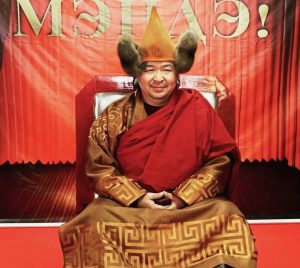Characteristics of Amitabha Buddha’s light
The Amitabha Sutra says:
The Buddha’s light shines boundlessly and without hindrance over all the worlds of the ten directions. It is for this reason that he is called Amitabha.
The name “Amitabha” means infinite light.
Since we know that a buddha’s name denotes an important aspect of his activity, and since that activity depends on the form in which a buddha chooses to manifest, we realize that we can know something profound about Amitabha by understanding his light. What kind of “light” does Amitabha Buddha possess? How can the Buddha’s light shine on us?
The Contemplation Sutra says:
Amitabha’s light permeates and shines over all the worlds of the ten directions that embraces and receives those sentient beings who think or recite his Name without forsaking them.
Why can’t we “see” Amitabha’s light? What happens when millions of people think or recite his Name at the same time? Can Amitabha’s light instantly shine over them at the same time?
The Contemplation Sutra also says:
Because all Tathagatas have cosmic bodies, they can enter into the mind of each sentient being. For this reason, when you think of a Buddha, your mind takes the form of his thirty-two physical characteristics and eighty secondary marks. When your mind thinks of the Buddha [by name, forms, and marks], it is itself the Buddha.
According to the words of Shakyamuni Buddha, we know that Amitabha Buddha’s activity and form is described using the analogy of light. However, Amitabha’s light is not the same kind of the light that we can see, such as sunlight, electric light, candlelight, and so on. Rather, it is a supernatural light that enters our minds and, without obstruction, works to transform and liberate us from within.
The Buddha’s form is described by light
Form and function are intimately connected. In terms of the functionality of the Buddha’s light, there are many similarities with light in the world. Just as worldly light can pierce the darkness of the physical environment, the Buddha’s light can dispel the darkness of ignorance in our minds so that we can clearly see the meaning of life, its aim, and direction.
Also, the Buddha’s light can give us wisdom, hope, peace, and joy. It can draw our attention, guide us home, relieve us from fear, and give us comfort when we are in despair. Again, worldly light has a similar function when we are lost in a wilderness at night. From these functions, we know that one of the forms taken by Amitabha Buddha in our Saha world is infinite, unobstructed, and supernatural light.
The meaning of “permeate and shine”
It is also stated that the Buddha’s light can enter into the minds of sentient beings who are mindful of the Buddha or who recite his name. If millions of people are mindful of the Buddha at the same time in different parts of the world(s), the Buddha’s light can enter their minds simultaneously.
This implies that the Buddha’s light is different from the worldly light that travels from one place to another. For instance, it takes about eight minutes for light to travel from the Sun to the Earth. However, the Buddha’s light permeates all worlds and enters the minds of all sentient beings who think or recite his Name simultaneously. Isn’t it inconceivable?
The meaning of “without hindrance”
According to the theory of karma in Buddhism, people perform good or bad actions (karma) through their bodies, mouths, and minds, incurring consequences of happiness and suffering, according to the Law of Cause and Effect. Thus, the Buddha advises us to refrain from evil and to perform good deeds.
Regarding “without hindrance” in the definition of Amitabha’s name, it refers to the ability of Amitabha’s light to eliminate the obstructions (due to greed, hatred, and delusion; arrogance, doubt, and wrong views) created by our karma so that we are physically and mentally liberated.
Worldly light is obstructed if there is an object in its path. Thus, the “back” of the object is dark and a shadow is cast. However, the Buddha’s light requires no medium of transmission and therefore suffers no obstruction. It co-exists with all sentient beings’ minds in the worlds of the ten directions.
What is a buddha’s light, actually?
In Buddhism, “light” is the mind activity of a sentient being. In a state of purity, the mind-nature or buddha-nature of all individual sentient beings is replete with a “light” that shines throughout the immeasurable and boundless cosmos.
Unfortunately, because of a single thought of “ignorance” (or discriminative thinking), all sentient beings fell into a state of delusion and are trapped in an ever-revolving cage of afflictions. This state is described as “darkness”, as the light of mind-nature is covered up by the “dusts” of matter, sound, smell, taste, and touch.
Subsequently, because of delusion, sentient beings perform karma, receive retribution, and suffer in the cycle of birth and death. This leads to an endless chain of rebirths within the Six Realms in the Three Domains of the Saha world.
All inhabitants in the Land of Bliss have the same form of light as Amitabha
How can we leave or exit the cage of darkness of birth and death? There are two ways. One is through the self-powered practices of precepts, meditation, and wisdom to eradicate greed, hatred, and delusion respectively. The other is through the other-powered practices of the Buddha’s compassionate vow power.
A buddha is an enlightened sentient being, while an ordinary being is an unenlightened buddha. For an enlightened buddha, his mind-nature in the form of “light” is perfectly and completely “recovered,” and he has the capacity to enlighten sentient beings by uncovering their original mind-nature.
Amitabha’s light is the foremost among all buddhas. Amitabha’s light can shine on all sentient beings and embrace those who think or recite his Name, so that they can be reborn in his Land of Bliss with the merit and virtues bestowed by him. By rebirth in the Land of Bliss, all living beings have the same body form of “light” as Amitabha Buddha.
Related features from BDG
The Body’s Appearance Upon Rebirth in the Land of Bliss
Why Did Amitabha Buddha Make the 19th and 20th Vows for Sentient Beings Who Aspire to Be Reborn in the Land of Bliss?
Master Shandao’s Interpretation of Amitabha’s 20th Vow of Deliverance












